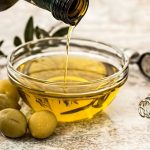Cooking oils are a necessary ingredient in all kitchens, regardless of what country or type of cuisine.
Every region of the world has one type of cooking oil which would be commonly available from the source of a plant found in that region. For example, people living near the ocean would have access to fish oil, while people living in the mountains would have access to olive oil. Caribbean cuisine uses coconut oil or peanut oil rather than olive oil like in Mediterranean cuisine.
Despite what many people think, you ought not get rid of your regular cooking oils to lower fats or lose weight. The type of oil you use for cooking is just as important as how much of it you use.
To choose the best cooking oil, you must consider what and how you intend to cook.
To select the best cooking oil for health, one should consider the cooking method (frying, baking, stir fry, grilling, or tempering) and the composition of the oil in terms of its smoking point.
Knowing the smoking point is essential to avoid releasing toxic compounds into your food and stripping essential nutrients from your ingredients.
Here are some of the healthiest cooking oils.
1. Olive Oil
Each EVOO (extra virgin olive oil) contains oleocanthal, a natural anti-inflammatory compound, making it a healthy oil.
Virgin olive oil has a higher quantity of monounsaturated fats than other oils, which improves HDL cholesterol with just 4 Tbsps a day.
Olive oil is good for drizzling over salads, Italian dishes, and cooking at very low heat. Although it has a low smoke point, it is still considered one of the best cooking oils for Indian cooking. Moreover, the beneficial polyphenols may degrade while cooking.
2. Sesame Oil
Sesame oil contains antioxidants like phytosterols, lignans, and sesamol, which scavenge free radicals in our bodies and help reduce the risk of chronic disease. Sesame oil has a balanced ratio of Omega 6 to Omega 3, which helps improve heart health and immunity.
Sesame oil, which is derived from sesame seeds, can be used for both culinary and medicinal purposes. Sesame oil is used in traditional Taiwanese and Chinese medicine to relieve joint pain, cuts, toothaches, scrapes, and menstrual cramps.
Sesame oil is high in polyunsaturated fat, so it should not be heated for long. Suited for medium-high flame cooking.
Oil pulling is a traditional way of improving dental health. Sesame oil can help remove harmful bacteria and promote oral hygiene.
3. Ghee
Ghee is packed with nutrients and is an important part of Indian cuisine. Ghee, which is a type of clarified butter, is high in fat-soluble vitamins which can help with weight loss.
This food is packed with nutrients that are great for brain development and digestion, like Omega 3 fatty acids, Vitamin A, E, K, and butyric acid. This oil is suitable for Indian cooking methods that involve frying, tempering, and making desserts. This is because the oil has a smoke point of 250 °C, which is much higher than most other cooking oils.
Ghee has a lot of health benefits, but it’s also high in saturated fat and calories. Only consume what is allowed per day.
4. Mustard Oil
It is the preferred cooking oil for Indian cooking. In northern India, mustard oil is commonly used for cooking.
This food is good for you because it helps your blood circulate and it has MUFA, PUFA, and alpha-linolenic acid. If you want to keep your heart healthy, you should consider adding mustard oil to your diet.
Its anti-infective properties can help treat digestive tract infections. Glucosinolate in mustard oil helps to reduce cancer risks. This oil has a high smoking point, so it can handle being heated to high temperatures for deep frying.
Mustard oil contains an anti-fungal component which protects food from fungal growth and is ideal for making pickles and treating dandruff.
Mustard oil contains vitamin E, improving skin health. Mustard oil can help to stimulate the body naturally, improve circulation and relieve sinus congestion.
5. Groundnut Oil or Peanut Oil
Peanut oil is the best oil for Indian cooking because it has a high smoke point.
Applying groundnut oil to the skin is a treatment for dry skin, eczema, arthritis, and joint pain. This is because groundnut oil is rich in Vitamin E.
Peanut oil contains high levels of vitamin E, monounsaturated fats (MUFAs) and polyunsaturated fats (PUFAs), folates, and protein, and low levels of saturated fat. In general, this type of oil is good for any kind of cooking.
Peanut oil is a flavorful oil that is pale in color and has a nutty aroma, peanut oil comes from the edible seeds of the peanut plant. Food experts say that it can handle high heat well, making it a good option for cooking Asian-style dishes and stir-fries.
Peanut oil has the highest level of monounsaturated fat compared to all other cooking oils, with a similar level of polyunsaturated fat to canola oil.
Peanut oil and grapeseed oil are both rich in the antioxidant vitamin E. However, it also contains very high levels of omega-6 polyunsaturated fat, so some health experts warn against using it until we know more about the effects of omega-6 fatty acids on our health.
6. Coconut Oil
Virgin coconut oil has been used to maintain healthy hair and massage the body for centuries. The white part of fresh coconuts are pressed in order to make coconut oil, which has many health benefits.
It is considered the best cooking oil for south Indian dishes in the southern parts of India. Oil is extracted from the dried coconut meat, also called copra, to produce refined coconut oil.
Coconut oil can help to hydrate your skin, fight bacteria and signs of aging.
Coconut oil contains a type of saturated fat known as Medium Chain Triglycerides (MCTs), which have been shown to boost metabolism and promote weight loss. MCTs may help people feel fuller after eating and prevent the body from storing fat.
In contrast, using too much coconut oil or choosing a commercial quality rather than virgin oil can have negative consequences. It is advisable to consume no more than 13 grams of coconut oil per day since it is mostly made up of saturated fat.
Coconut oil is good for oil pulling. Oil pulling means swishing oil around in your mouth to remove harmful bacteria. It helps prevent dental inflammation and balance the hormones.
READ MORE: Coconut Oil Health Benefits
7. Avocado Oil
The oil made from avocados has a taste similar to the fruit, and can be used in high temperature cooking, like stir fry, grilling, and roasting, or in salads.
Avocado oil contains more monounsaturated fat than any other cooking oil, with the exception of olive oil. Avocado oil is similar to olive oil in that it contains low levels of polyunsaturated fats and is rich in oleic acid.
More research is needed to be certain of the health benefits of avocado oil, but initial studies suggest that it can lower cholesterol, improve cardiovascular health, help with eye health, and allow the body to absorb other essential nutrients more easily.
Avocados boast a higher saturated fat content than most other vegetable oils at 20%. The percentage of saturated fat in olive oil is much smaller than the percentage of saturated fat in butter, lard, or tropical oils such as coconut or palm oils.
Although avocado oil may be more expensive than other oils, Alice Lichtenstein says that it is a fine oil to use. Alice Lichtenstein is a professor of nutrition science and policy and director of the cardiovascular nutrition laboratory at the Tufts University Human Nutrition Research Center on Aging in Boston.
8. Canola Oil
This neutral-flavored oil comes from a plant called rapeseed. Canola oil is versatile and practical, and can be used for a variety of purposes including baking, grilling, stir-frying, and making salad dressings. It is also relatively inexpensive.
Canola oil has a higher than average amount of monounsaturated fat, which is good, and a good amount of polyunsaturated fat.
Canola oil has the lowest level of saturated fat among cooking oils and contains a beneficial plant-based source of omega-3 fats.
A review of studies found that canola oil can reduce people’s risk of heart disease.
9. Grapeseed Oil
Grape seed oil is extracted from grape seeds that are left over from making wine. A mild-flavored oil that is favored by chefs and foodies alike, grapeseed oil can be combined with other, stronger flavors.
It has a neutral flavor and a high smoke point, making it a good choice for cooking. The Cleveland Clinic advises storing the grapeseed oil in the refrigerator to prevent it from becoming rancid.
Grapeseed oil is a good source of vitamin E, which is an important antioxidant. This food also has a lot of omega-6 polyunsaturated fat.
While some evidence, such as a study published in the Missouri Medicine journal, points to omega-6 fats increasing the risk of obesity, autoimmune diseases, asthma and allergies, another study published in Food & Function found that the type of omega-6 fats found in rapeseed oil can lower inflammation. So we need more research to discover how grape seed oil can improve our health.
10. Vegetable Oil
Historically, the vegetable oil that has been most commonly used is soybean oil. Nowadays, the term may also refer to a mixture of different oils.
Soybean oil is a type of vegetable oil that is flavorless and versatile. It can be used for cooking, sautéing, frying, and making salad dressings.
Soybean oil is not primarily saturated, with only 15% saturated fat. Soybean oil contains omega-3 fats, which are heart-healthy fats often found in salmon and sardines but less common in plant-based food sources.
11. Sunflower Oil
Sunflower oil is light in color and has a neutral flavor. It has a high concentration of polyunsaturated fat. It is a heart-healthy option because it contains some monounsaturated fat and is low in saturated fat.
Sunflower oil is a good option for cooking because it can be exposed to high temperatures without breaking down, making it good for roasting, frying and deep-frying.
There are three types of sunflower oil available in the U.S. for home cooking, each of which have been modified to have different fatty acid profiles:
- High linoleic acid
- Mid-oleic
- High oleic
If you want to change how sunflower oils behave during cooking, you need to modify them to have higher levels of linoleic or oleic acid. All three oils have the same levels of saturated fat, but high oleic contains more monounsaturated fat and high linoleic contains more polyunsaturated fat.
A diet rich in oleic acid has been linked to lower cholesterol levels and a reduced risk of heart disease. It may also increase good cholesterol. As a result, the U.S. The Food and Drug Administration has approved health claims for high oleic sunflower oil.
Takeaway
It’s important to rotate the different types of oils you use for cooking so that your body gets a variety of nutrients. You can increase the efficiency of two or more different oils by rotating them and balancing the fatty acids and antioxidants.
When choosing fats to include in your diet, it is beneficial to incorporate both saturated and unsaturated fats. However, it is ideal to be mindful of the amount of each type of fat you consume.
The Mayo Clinic and the Cleveland Clinic both agree that olive oil is the best type of oil to use for a heart-healthy lifestyle, although other oils can also provide similar benefits.
When cooking, the Dietary Guidelines for Americans recommends switching from butter, lard, or shortening to vegetable oil to reduce the amount of saturated fat in the diet.









